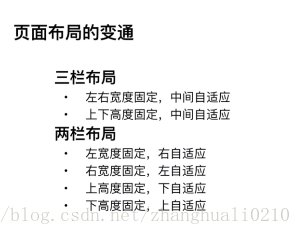问题:
假设高度已知,请写出三栏布局,其中左栏、右烂宽度各为300px,中间自适应
方式一:使用浮动解决
<!DOCTYPE html>
<html lang="en">
<head>
<meta charset="UTF-8">
<title>Title</title>
<style>
html *{
padding:0;
margin:0;
}
div{
height: 100px;
}
.left{
float: left;
width:300px;
background: red
}
.center{
background: gold;
}
.right{
float:right;
width: 300px;
background: green;
}
</style>
</head>
<body>
<div class="left-right-center">
<div class="left"></div>
<div class="right"></div>
<div class="center"></div> <!--这里的中间center要写在left和right后面,否则得不到想要的结果-->
</div>
</body>
</html>
方式二:使用绝对定位
<!DOCTYPE html>
<html lang="en">
<head>
<meta charset="UTF-8">
<title>Title</title>
<style>
html *{
padding:0;
margin:0;
}
div{
height: 100px;
}
.left-right-center{
width: 100%;
position: absolute;
}
.left{
width:300px;
background: red;
position: absolute;
left:0;
}
.center{
background: yellow;
position: absolute;
right:300px;
left:300px;
}
.right{
width: 300px;
background: blue;
position: absolute;
right:0;
}
</style>
</head>
<body>
<div class="left-right-center">
<div class="left"></div>
<div class="center"></div> <!--此时center在中间,这样布局的结果是当浏览器宽度小于600px时,两个左右300px的元素会重合-->
<div class="right"></div>
</div>
</body>
</html>
方式三:使用flexbox
<!DOCTYPE html>
<html lang="en">
<head>
<meta charset="UTF-8">
<title>Title</title>
<style>
html *{
padding:0;
margin:0;
}
div{
height: 100px;
}
.left-right-center{
display:flex;
}
.left{
width:300px;
background: red;
}
.center{
background: yellow;
flex: 1;
}
.right{
width: 300px;
background: blue;
}
</style>
</head>
<body>
<div class="left-right-center">
<div class="left"></div>
<div class="center"></div> <!--这里要注意,当屏幕宽度小于600px以后,左右两侧的300px也会减少-->
<div class="right"></div>
</div>
</body>
</html>
方式四:使用表格布局
<!DOCTYPE html>
<html lang="en">
<head>
<meta charset="UTF-8">
<title>Title</title>
<style>
html *{
padding:0;
margin:0;
}
div{
height: 100px;
}
.left-right-center{
width:100%;
display: table;
height:100px;
}
.left{
width:300px;
background: red;
display:table-cell;
}
.center{
background: yellow;
}
.right{
width: 300px;
background: blue;
display:table-cell;
}
</style>
</head>
<body>
<div class="left-right-center">
<div class="left"></div>
<div class="center"></div> <!--这里要注意,当屏幕宽度小于600px以后,左右两侧的300px也会减少-->
<div class="right"></div>
</div>
</body>
</html>
方式五:使用网格布局
<!DOCTYPE html>
<html lang="en">
<head>
<meta charset="UTF-8">
<title>Title</title>
<style>
html *{
padding:0;
margin:0;
}
div{
height: 100px;
}
.left-right-center{
width:100%;
display:grid;
grid-template-rows: 100px;
grid-template-columns: 300px auto 300px;
}
.left{
background: red;
}
.center{
background: yellow;
}
.right{
background: blue;
}
</style>
</head>
<body>
<div class="left-right-center">
<div class="left"></div>
<div class="center"></div>
<div class="right"></div>
</div>
</body>
</html>
问题延申
一、每个解决方案的优缺点?
解答:(1)浮动,是脱离文档流的,会带来很多问题。但是兼容性比较好。
(2)绝对定位,适用快捷。因为你已经脱离文档流了,那么你下面的子元素也必须脱离文档流。导致了可使用性差。
(3)flexbox布局,是CSS3中新出现的布局方式,为了解决上述两种方案的不足才出现的。它比较完美,在移动端基本都是flex布局。
(4)表格布局的兼容性是非常好的,三栏布局当其中一个单元格超出的时候,两侧的单元格也会调整高度。
(5)网格布局,代码少。
二、假设把高度去掉,考虑纵向,哪个不适用了?
方式一、方式二、方式五不能用。
三、考虑到兼容性,真正的运用到业务中去,哪个是最适用的?
四、页面布局的变通






















 1560
1560

 被折叠的 条评论
为什么被折叠?
被折叠的 条评论
为什么被折叠?








